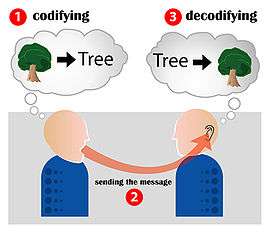Everett Rogers
| Everett M. Rogers | |
|---|---|
| Born |
Everett Mitchell Rogers March 6, 1931 Carroll, Iowa |
| Died |
October 21, 2004 (aged 73) Albuquerque, New Mexico |
| Occupation | Distinguished Professor, Researcher, Educator, Consultant |
| Language | English |
| Nationality | United States |
| Citizenship | United States |
| Education |
B.S., Iowa State University M.S., Iowa State University Ph.D., Iowa State University |
| Alma mater | Iowa State University |
| Subject | Development Communication, International Communication, Communication Theory |
| Notable works | Diffusion of Innovations, Communication Technology, A History of Communication Study |
| Spouse | Corinne Shefner-Rogers |
| Children | David Rogers, Everett King |
Everett M. Rogers (March 6, 1931 – October 21, 2004) was a communication scholar, sociologist, writer, and teacher. He originated the diffusion of innovations theory and introduced the term early adopter.
Rogers was born on his family's Pinehurst Farm in Carroll, Iowa, in 1931. His father loved electromechanical farm innovations, but was highly reluctant to utilize biological–chemical innovations, so he resisted adopting the new hybrid seed corn, even though it yielded 25% more crop and was resistant to drought. During the Iowa drought of 1936, while the hybrid seed corn stood tall on the neighbor’s farm, the crop on the Rogers' farm wilted. Rogers' father was finally convinced.[1]
Rogers had no plans to attend university until a school teacher drove him and some classmates to Ames to visit Iowa State University. Rogers decided to pursue a degree in agriculture there. He then served in the Korean War for two years. He returned to Iowa State University to earn a Ph.D. in sociology and statistics in 1957.
Diffusion of innovations
When the first edition of Diffusion of Innovations was published in 1962, Rogers was an assistant professor of rural sociology at Ohio State University. He was only 30 years old but was becoming a renowned academic figure. In the mid-2000s, The Diffusion of Innovations became the second-most-cited book in the social sciences. (Arvind Singhal: Introducing Professor Everett M. Rogers, 47th Annual Research Lecturer, University of New Mexico) . The fifth edition (2003, with Nancy Singer Olaguera) addresses the spread of the Internet, and how it has transformed the way human beings communicate and adopt new ideas.
Rogers proposes that adopters of any new innovation or idea can be categorized as innovators (2.5%), early adopters (13.5%), early majority (34%), late majority (34%) and laggards (16%), based on the mathematically based Bell curve. These categories, based on standard deviations from the mean of the normal curve, provide a common language for innovation researchers. Each adopter's willingness and ability to adopt an innovation depends on their awareness, interest, evaluation, trial, and adoption. People can fall into different categories for different innovations—a farmer might be an early adopter of mechanical innovations, but a late majority adopter of biological innovations or VCRs.
When graphed, the rate of adoption formed what came to typify the Diffusion of Innovations model, a logistic curve) The graph shows a cumulative percentage of adopters over time – slow at the start, more rapid as adoption increases, then leveling off until only a small percentage of laggards have not adopted.[2]
His research and work became widely accepted in communications and technology adoption studies, and also found its way into a variety of other social science studies. Rogers was also able to relate his communications research to practical health problems, including hygiene, family planning, cancer prevention, and drunk driving.
Entertainment education
In the early 1990s Rogers turned his attention to the field of Entertainment-Education. With funding from Population Communications International, he evaluated a radio drama designed to improve public health in Tanzania called Twende na Wakati (Let’s Go With the Times). [3] With Arvind Singhal of Ohio University he co-wrote Entertainment Education: A Communication Strategy for Social Change.
To commemorate his contributions to the field, the University of Southern California Norman Lear Center established the Everett M. Rogers Award for Achievement in Entertainment-Education, which recognizes outstanding practice or research in the field of entertainment education.
Later life
In 1995, Rogers moved to the University of New Mexico, having become fond of Albuquerque while stationed at an airbase during the Korean War. He helped UNM launch a doctoral program in communication. He was Distinguished Professor Emeritus at UNM.
Rogers suffered from kidney disease and retired from UNM in the summer of 2004. He died a few months later, survived by his wife, Dr. Corinne Shefner-Rogers, and two sons: David Rogers and Everett King.
See also
- Communication sciences
- Communication studies
- Communication theory
- Development communication
- Diffusion of innovations
- D. Lawrence Kincaid
- Mass communication
- Mass media
- Technology adoption lifecycle
- Wilbur Schramm
References
- ↑ Singhal, Arvind; Thomas E. Backer (2005). "FORUM: THE LIFE AND WORK OF EVERETT ROGERS—SOME PERSONAL REFLECTIONS". Journal of Health Communication. 10: 285–288. doi:10.1080/10810730590949978.
- ↑ [Rogers, Diffusion of Innovations 1983]
- ↑
External links
- Distinguished Communication Professor Influenced Countless Lives
- Communication/Journalism Professor Selected for UNM's Highest Faculty Honor
- Scholarship to Honor Distinguished Communication Scholar Everett Rogers
- Everett M. Rogers Award for Achievement in Entertainment-Education
- Communication and Development: The Passing of the Dominant Paradigm
- Edward T. Hall and the History of Intercultural Communication: The United States and Japan
- The Danger of the "Early Adopter" Myth
- Journal of health communication forum
- Journal of health communication commentaries
- Journal of health communication article
